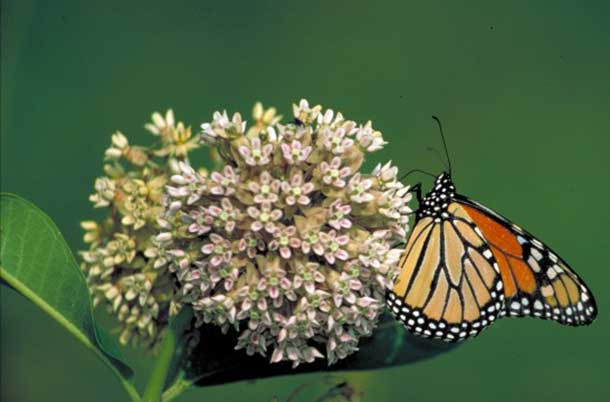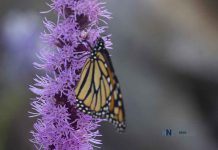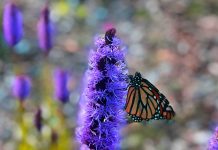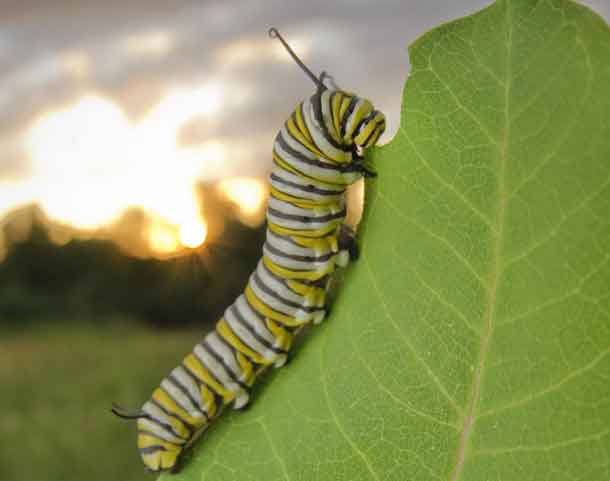
Coconut Creek, Broward County, Florida – A Butterfly’s flying distance during its annual migration amounts to the third longest journey of any species in our hemisphere. Departing Central America in Spring and travelling north to Thunder Bay, and other regions in Canada, their journey covers 2,000 miles. I was playing the Beatles CD: A Magical Mystery Tour –how fitting- -as I sat, in shorts, on a tropical Veranda compiling and writing notes.
The longest migration–an incredible 10,000 mile trip–is covered in the truly methodical odyssey of a gray whale leaving after leaving her calving lagoon in Baja California. Then swimming, with her newborn, all the way north along the Pacific corridor to Alaska and the Russian straights in the Bering Sea. Migrating humming birds have the second longest migration.
Only a days before going to Broward County, in Florida, to study both wild butterflies and resident humming birds I retired at what we’ve called our Kipling Cottage to read Rudyard’s Butterfly poem.
Rudyard Kipling was sketching a scene of children chasing butterflies in a garden.
Eyes aloft, over dangerous places,
The children follow the butterflies,
And, in the sweat of their upturned faces,
Slash with a net at the empty skies.
So it goes they fall amid brambles,
And sting their toes on the nettle-tops,
Till, after a thousand scratches and scrambles,
They wipe their brow and the hurting stops.
He could have penned it yesterday watching adults playing at croquet, lawn bowling, where children slipped in-and-out of that relaxed scene with home made nets on bamboo handles pursuing elusive butterflies between English ivy and eucalyptus hedges. My mind immediately compared this tropical clip to kids back home, in Thunder Bay, chasing pucks on outdoor ice rinks.
However in preparing for a trek at what Dutch born Ronald Boender, designer and builder of Coconut Creek’s International Aviary, has simply called The Butterfly World; I had been building a thickening file on butterflies. Because when scientific minds go deep into a subject what is gleaned often becomes such a revelation.
As when the Grants (Peter & Rosemary) were recently at Lakehead University detailing their life’s work in the Galapagos they were also telling me about the awe inspiring findings lab researcher at Princeton were seeing in studying fruit flies. Of all things. Their small to large studies (micro to macro term for it) under microscopes revealed ways in our elderly might be treated for knee and leg joint treatments. Besides, studies in sleep depravation sensitivity to light sources. “That’s the remarkable-ness of delving,” Peter told me with a grin.
Dutch born architect ***Quotes include Mohammed Ali ***whistler, Vincent composition of an instrumental from Europe just called Spanish Butterfly
So my reading and referencing was well structured, as I stepped into the foyer of the Butterfly Museum. There was immediate talk, among staff and guides, that a group of U.S. Army engineers were on sight looking at a butterfly’s mechanism in adapting and being able to camouflage their presence living in the aviaries.
Not to be outdone, technical experts from China had been there and were developing a new method to produce a long lasting pigmentation in paints as mind boggling as it may seem. I’ll touch on that when looking at how butterflies reflect their colours in the tones on their wings.
Yet another technical lab, also from the Asia, was here in a redeeming effort to use data collected in pursuing a method in Oriental perfume extractions. Something so new it occurred to me these early anecdotes might elicit the same kind if mind-boggling reaction Marco Polo must have once drawn from his long journey to China and coming back with his Italian adventures in the silk trade. Spun by the phenomenal life cycle of silk worms.
And just to touch on historical situations with butterflies lifting things to a contemporary level. A driving 45 degree angle, torrential, monsoon-like rainstorm began that afternoon.
Don’t think I have ever become so soaked in a deluge of water like that before. Everything from my notebooks, art materials, and guide brochures were drenched in my back pack. The Panama white shirt, my trousers and boat shoes were sodden in water as we were caught on a wide open bridge when the heavens opened. Unexpected? Yes. “Though that’s what living in the Gold Coast teaches you,” said a Floridian who was wise enough to bring a towell. She was during her two children. The neat part was the rain was balmy. It was almost like someone had put a nozzle on a hose and connected it to a sauna source.
Now, our conversation turned to the migration of butterflies. How far they go during life cycle changes. And, do they have internal strength enough ‘to wing it out’ over large gaps of water between landscapes they travel.
The answer to this came as long ago as when Columbus said to America. Out in the vastness of sea water Columbus logged the imagery of a very large cloud of butterflies that hovered for a time over his sailing vessel. His crew was impressed.
Boendner’s Official Opening came about in March of 1988. As with all good designs what he had engineered became a living variation in science. Developed after going to England to look at what were called ‘butterfly houses.’ Where one of Britain’s finest, most well acquainted with the industriousness and lives of wild butterflies, was Clive Farrell. He joined up as an Associate with Ronald Boender and this worthy-of-vist any time Museum has become the spectacle of life before us.
Besides, they felt a substantial pull within their vision and have amalgamated various species of colourful humming birds. Plus lorikeets and parakeets adapted to situations found in NewGuinea, Australia and elsewhere. There is–inside– a vast collections of BUGS covering what are native to Malaysia, the Philippines, the Orient and South America.
Caught, later, trekking across a pathway where butterflies rather instinctively did a quick turn about veering away from our entry. A page from Scientific American was relevant. America. Their story reveals that butterflies might be called left-handed travellers. To get to the quick of this, if one assumes moving between two points: A to B what might be the norm is a straight and true oath. Spending time on the motion of butterflies what came about rings nicely true. If a butterfly’s path is blocked or stymied instead of following a conservative obvious course, butterflies will assume a deft left-handed adaption. They automatically swerve quickly, diligently, and fly away from any blockages. It may be comparable to teaching a young hockey player to make the most of a tight turn to avoid a checker. These educational methods and ways in living all relate to the life of wild creatures whose nesting sights, and habits, inside the Gold Coast illustrate keys to any proverb bout survival.
Up close inside this Museum the most startling butterfly that ranks as everyone’s favourite is the absolutely brilliant Blue Morph. Morph a short term for the metamorphosis butterflies go through. The miracle-like imagery if blue morph butterflies hovering, flitting and alighting right where you are is a reflection of what Henry David Thoreau said about blue birds. It’s as if they have a patch of a bright blue sky in them.
While witnessing a collection of blue morphs in this setting one from the Economist magazine stationed, in Chicago, was beside me in spirit writing a piece about how different species show their colours. His focus was on Iberian lizards whose heads turn emerald during mating season. But then how do they do a kind of Houdini change of costume colouring with, possibly, a raptor in the sky? That was his long term thesis.
What we defined was the iridescence in nature is because of microscopic structures in the animal. This extremely fine layer is known as chitin contained in a butterfly’s wings. Where wavelengths with a sunshine source are splayed out. Mother nature’s pigmentation affecting such exotic tones bursting out in vibrant oranges, reds, purples and the masterful vitality of a blue morph. Is this why Cassius Clay came to the forefront of boxing in the sixties with his M.O., “ya gotta float like a butterfly, and, sting like a bee.” Well in advance of’ his own morph time’. changing into Mohammed Ali.
As well, the specialized enthusiasm of developers in the perfume trade are on top of this to an extent that their further publications will only educate us in a much, much broader sense.
This like a fine moment to pause for a tea. Dry off. Examine photos taken. And, resume our fresh look at resident butterflies in Florida.
Ronn Hartviksen
More to come from Florida….




